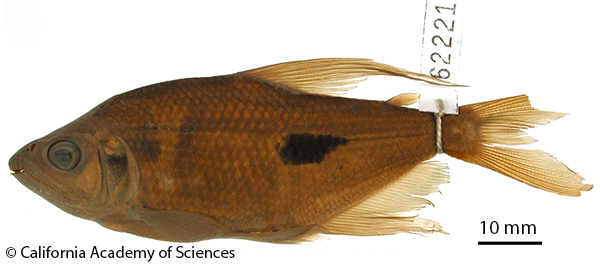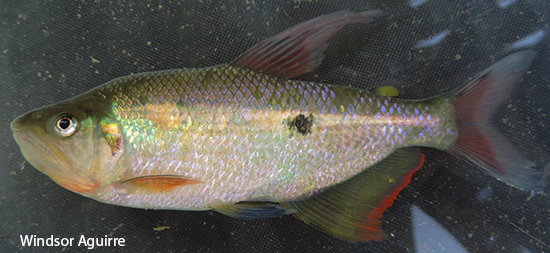| SOURCE FOR OCCURRENCE IN ECUADOR: Multiple sources for its occurrence in Ecuador, e.g., Bohlke (1958), Glodek (1978), Barriga (1991). |
| ORIGINAL DESCRIPTION: Eigenmann, C.H. and A.W. Henn. 1914. On new species of fishes from Colombia, Ecuador, and Brazil. (Contrib. Zool. Lab. Ind. Univ. No. 140). Indiana University Studies No. 24: 231-234. |
| TYPE SPECIMENS: |
| TAXONOMIC STATUS: Listed as valid by Eschmeyer and Fricke (2011). However, Gery (1977) suggested it may be a geographic subspecies of R. altipinna that occurs at high altitudes. Bohlke (1958) also indicated that R. altipinna and R. minor seem to blend into each other at altitudes between 300-900 m in the Esmeraldas River. |
| RANGE ECUADOR: Exact distribution unclear. Glodek (1978) lists this species for the Esmeraldas drainage in northwestern Ecuador. Barriga (1991) lists it as occurring both in the northern and southwestern Ecuador. |
| RANGE OUTSIDE OF ECUADOR: Unclear. Fish base lists this species as being restricted to western Ecuador. However, Glodek (1978) indicates that it also occurs in western Colombia from the Rio Patia southward. |
| COLLECTIONS IN ECUADOR: NA |
| MAXIMUM SIZE: 10.4 cm SL (Fish Base, 2011) |
| DISTINGUISHING FEATURES: This is a small tetra that is sexually dimorphic, with males being larger than females (Glodek, 1978). It is morphologically similar to Rhoadsia altipinna, a common congener that occurs in the lowlands of western Ecuador. Rhoadsia minor is generally smaller, reaching a maximum body size of about 10.4 cm SL (Fishbase, 2011). R. minor is also more slender than R. altipinna, with its body depth fitting 2.8 to 3.0 times in SL, while in R. altipinna body depth fits 2.25 to 2.50 times in SL (Glodek, 1978). Rhoadsia minor occurs at high altitudes and is typically found above 1,000 m (Gery, 1977), whereas R. altipinna is common at low elevations. Gery (1977) suggested that R. altipinna and R. minor may be geographical subspecies rather than good species. Bohlke (1958) indicated that R. altipinna and R. minor seem to blend into each other at altitudes between 300-900 m in the Esmeraldas River. A detailed comparison of these two species appears necessary to validate their status as distinct species. |
| ECOLOGY: NA |
| ECONOMIC IMPORTANCE: A relatively small fish, it is not of direct economic importance. May have potential as an ornamental fish because of the bright colors on its fins (Gery, 1977). |
| CONSERVATION STATUS: NA |
| LINK TO FISHBASE PAGE: Click here for link |
| SPECIES PROFILE CREATED BY: Windsor Aguirre |
| SPECIES PROFILE CONTRIBUTORS: NA |

